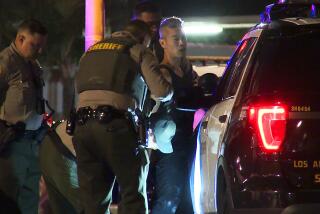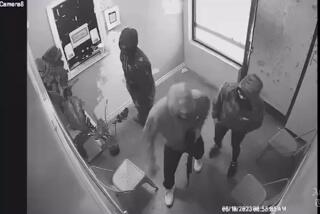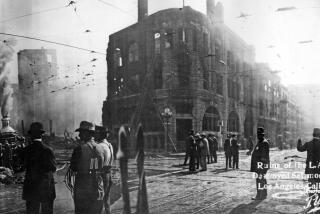10 Minutes of Terror Seemed Like an Eternity
Survivors of Tuesday’s deadly massacre at a San Diego electronics company remember the afternoon attack in snippets.
There was the clang of the fire alarm, which went off shortly after 2:15 p.m. when Larry T. Hansel, a former employee who had been laid off in March, entered the Elgar Corp. headquarters and exploded two homemade bombs. There was the sharp smell of smoke and the paralyzing feeling that Hansel, commando-like with a shotgun and a bandoleer of ammunition slung around his chest, might be around the next corner.
But most frightening, those who encountered Hansel said, was how efficient and cool-headed he appeared, seemingly at peace with his violent purpose.
“He seemed to be very deliberate,” said Jess Marinez, Elgar’s director of business development, who had watched from 15 feet away as Hansel shot two other executives at point blank range. “He knew what he was doing and he knew what people he was dealing with . . . . He knew what to do pretty quick.”
Hansel was in custody Wednesday in San Diego, where a police spokesman said he was cooperating with investigators. Officials said Hansel has confessed to killing two of Elgar’s top executives--John Gary Jones, 48, a vice president, and Michael B. Krowitz, 46, a regional sales manager--but that he expressed no remorse.
On Wednesday, those who had survived the gunman’s methodical assault tried to make sense of what they’d seen and heard during the brief, hellish period--Marinez estimated it was less than 10 minutes--that the building was under attack.
Some employees had jumped to safety out of second-floor balconies. Others had fled to the roof, maneuvering down hallways choked with odd-smelling smoke before breaking free into the fresh air. Others, like Roxann Merlini, had taken cover under desks, holding their breaths and praying as the air shook with gunfire and the crack of shattering glass.
“I was afraid to close my eyes,” said Merlini, 36, a sales coordinator who was on the second floor when the explosions began. “Normally when I’m afraid, I close my eyes. (But) I was looking for feet or legs walking past.”
Bill Humphreys, Elgar’s president, said that at first he thought all he was dealing with was a fire. At about 2:20 p.m., after the first boom of an explosion shook the two-story building, Humphreys said one of his supervisors called 911 to alert firefighters about the flames, some of which shot 15 feet in the air.
But soon, as Hansel strode from a rear entrance down a hall towards the central stairway, those in his path said they knew the fires were just the beginning.
Witnesses said Hansel conducted a controlled search, “point-blanking” former colleagues he met with a steady stare, inquiring about the whereabouts of Jones, the vice president, and other managers, and then determinedly moving on.
Chris Kelford, the chief financial officer, came face to face with Hansel in the hallway.
“He looked me straight in the eye and said, ‘You can go,’ ” he said. “He was in control. He knew what he wanted to do. He was looking for someone in specific.”
According to police, Hansel had targeted as many as six managers, among them: Jones, Tom Erickson, the vice
president of human resources, and floor supervisor Bob Azima.
Hansel first stopped at the reception area, ordered receptionist Dorothy Bright aside and shot out the telephone switchboard. Then, he headed upstairs, to the executive offices.
“He ran up the stairs,” Bright told a radio reporter. “He was taking it two or three steps at a time.”
One man who saw Hansel told him he was sorry that he had been laid off.
“I’m sorry too,” Hansel said, continuing up the stairs.
Merlini, the sales coordinator, was discussing a potential $3 million deal in Krowitz’s office when they heard explosions. Merlini and Krowitz looked at each other, baffled for a moment, before another colleague yelled out a warning: “Everybody get out! Somebody’s got a gun!”
Krowitz abruptly ended a conference call, and they fled. Merlini turned right, towards the exits. But Krowitz, who one neighbor described Wednesday as a former policeman who “definitely wasn’t a wimp,” went to the left, apparently to check on Jones, his boss. It was a heroic decision that may have cost Krowitz his life. Krowitz was not among the executives being stalked by Hansel.
Erickson, whose office--a few doors down from Krowitz’s--exited onto the same central reception area, heard the warning too. He did not know Hansel was looking for him, but he ran out of his office toward the finance office nearby, ducking under a desk.
Moments later, as Merlini huddled under a desk, Hansel walked swiftly into the reception area, looked at several people and then confronted Jones and Krowitz, who stood together near a fax machine.
Fifteen feet away, Marinez, the director of business development, stood in his glass-walled office and watched as Hansel shot at Jones, who fell to the ground. Hansel then turned to Krowitz and fired three times, hitting him in the right upper chest, the left abdomen and the left leg. Then, Marinez said, Hansel bent over Jones, aimed at his head and shot again.
After he was sure that the area was clear, Marinez ran to a second-floor balcony and jumped into a row of bushes below, injuring one of his legs.
“This guy’s got shells sticking out all over him, holding a gun with a strap,” Marinez said. “He never saw me, thank God.”
Erickson stayed crouched under the desk in the finance department.
“You ever play hide and go seek, how terrible it is when they find you?” he asked. “Imagine if that person has a gun.”
After the shooting stopped, he heard the gunman bellow: “Anybody left on the second floor?”
Nobody answered.
Soon, Erickson crept out from his hiding spot and tried to phone for help, but the phones were dead. With two other employees, he went downstairs, heading towards the back exit. But, before he reached it, he saw Hansel for the first time. He was straight ahead, staring off into another direction with the gun still in his hand.
“I said, ‘ That’s who it is,” Erickson recalled. “Well, that’s Larry.”
Erickson turned around and ducked down another corridor.
William Bajis, a supervisor at Elgar’s micro products division, said he was putting out a fire at one of the building’s rear entrances when Hansel emerged from the building about 15 feet away. He looked calm, Bajis said, seemingly unrattled by the carnage he’d left behind.
“His head and eyes were looking straight ahead, like he had a destination to go to and he wasn’t going to let anybody stand in his way,” said Bajis, who watched as Hansel headed for the getaway bicycle he’d parked about 100 yards from the building.
“He walked. He didn’t run, he just walked. He didn’t look at anybody. He kept his eyes straight ahead,” Bajis said.
Still, Bajis said, the sight of Hansel frightened a group of about 75 Elgar employees who had gathered outside.
“They saw him with the shotgun and suddenly scattered in all different directions,” he said. “They looked like a flock of pigeons on the sidewalk, flying away when a person walks into the middle of them.”
Moments later, Reggie Saunce, who works at the Tri-West warehouse next door to Elgar, was talking to a group of Elgar employees about the mayhem when someone spotted the gunman pedaling away.
“There he goes,” Saunce heard someone say.
This story was reported by staff writers Mark Platte, H.G. Reza, Amy Wallace and Nora Zamichow.
More to Read
Sign up for Essential California
The most important California stories and recommendations in your inbox every morning.
You may occasionally receive promotional content from the Los Angeles Times.










